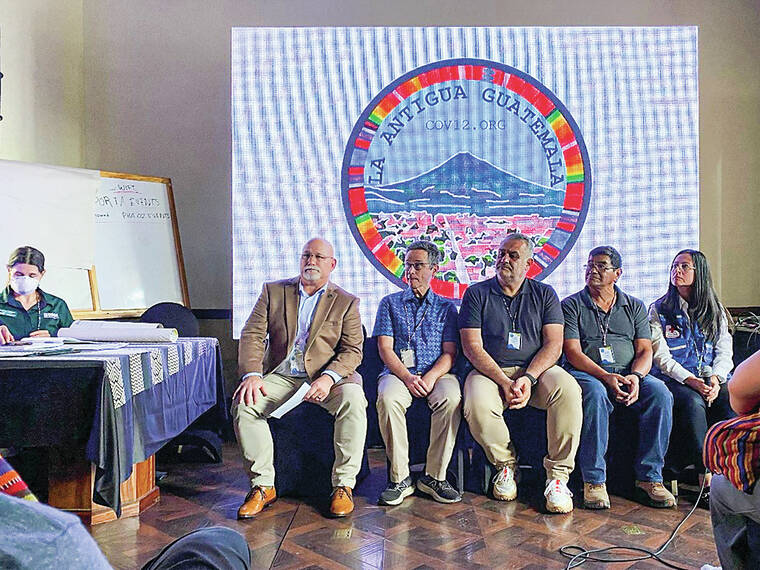Volcano Watch: What was an emergency manager doing at a scientific conference?
On the Island of Hawaii, frequent eruptions foster a close relationship between the USGS Hawaiian Volcano Observatory and the Hawaii County Civil Defense Agency. HVO monitors the active volcanoes and their associated hazards; HCCDA alerts and protects communities from impacts of volcanic events. This relationship, between volcano observatories and their emergency managers, was highlighted at the recent “Cities on Volcanoes” meeting in Antigua, Guatemala.
The COV meeting is held every other year, and it brings scientists from around the world together to share information on the latest eruptive activity and how communities have been impacted, and to present studies on the effects of volcanism. This year, with financial support from the USGS Volcano Science Center, I attended the twelfth COV meeting in Antigua because one of the conference’s four themes, “From volcano monitoring and hazard assessment to risk management,” had a strong emergency management focus.
In Hawaii, HVO monitors the active volcanoes, determines what hazards we can expect during unrest, and tracks eruptions. HVO is also responsible for setting the volcano alert levels and aviation color codes in Hawaii and American Samoa, using the USGS Volcano Alert Level System for Volcanoes. In this capacity, HVO notifies federal, state, and local emergency management agencies, as well as the residents and visitors, of notable volcanic unrest and eruptive activity. HCCDA is then responsible for disseminating alerts about volcanic activity (and other natural or man-made hazards) via our public information and warning system. HCCDA is also responsible for making emergency management decisions, such as road closures or evacuations, if communities or infrastructure are being threatened by volcanic activity.
Over the five-day COV meeting in Antigua, the reason HVO wanted HCCDA to attend became very apparent. The relationship between HCCDA and HVO exists beyond volcanic unrest; we talk to and share information with each other even when Hawaii’s volcanoes are at alert-level normal. What makes our relationship unique is that HCCDA can ask the scientists at HVO questions about the current situation, and they are willing to have a candid conversation about the unrest or eruption. Through these conversations, HCCDA is then able to determine and convey the magnitude (dire versus non-threatening) of the current situation to the public.
Hawaii is fortunate to have such a close relationship between scientists and emergency managers. In some countries, the collaboration between these two groups appears strained. From the outside, it appears that part of the conflict between volcano observatory scientists and emergency managers is the result of their roles not being clearly defined.
In other places in the world, the responsibilities for setting volcano alert levels and for providing public information and warning appear to be not clearly assigned, or if assigned, not understood by one or more of the organizations involved in the response. This has led to confusion in the public on how serious the threat is and on what actions they need to take. For example, on the Caribbean island of Montserrat, many residents were evacuated in the 1990s from the most threatened area many months before any impacts from eruptions happened. Some individuals who had evacuated returned to their homes because of the lack of impacts, only to perish during the most devasting pyroclastic flow months later. While many factors contributed, in retrospect it appears clearer messaging and communication may have saved more lives.
A similar situation occurred in Guatemala in 2018 where the volcano observatory communicated their observations to emergency managers, but some believe that the magnitude of the eruption and its potential hazards was under appreciated, which resulted in a community not being adequately warned to evacuate. A pyroclastic density current destroyed the community and hundreds of residents perished.
The focus of the COV meeting was on improving all aspects of monitoring, evaluating, and communicating volcanic activity.
It’s clear that emergency managers and volcano observatories need to work closely together so that emergency managers can get the volcano hazards information that we need to fulfill our obligations to protect life and property during a volcanic event. Emergency managers at HCCDA and scientists at HVO share the same passion for their work, and we will continue working closely together in the future, as new volcanic activity occurs on the Island of Hawai‘i.
Volcano activity updates
Kilauea is not erupting. Its USGS Volcano Alert level is ADVISORY. Low levels of disbursed seismicity continue at Kilauea’s summit and along the Koa‘e fault system southwest of the caldera. Earthquake counts remained below 10 per day until March 11; since March 11, there has been a minor increase in activity, with up to 60 disbursed events occurring per day in this region. Tiltmeters near Sand Hill and Uekahuna bluff have continued to record modest inflationary trends over the past week. No unusual activity has been noted along the rift zones.
Mauna Loa is not erupting. Its USGS Volcano Alert Level is at NORMAL.
Webcams show no signs of activity on Mauna Loa. Summit seismicity has remained at low levels over the past month.
Ground deformation indicates continuing slow inflation as magma replenishes the reservoir system following the 2022 eruption. SO2 emission rates are at background levels.
There were no earthquakes reported felt in the Hawaiian Islands during the past week.
HVO continues to closely monitor Kilauea and Mauna Loa.
Please visit HVO’s website for past Volcano Watch articles, Kilauea and Mauna Loa updates, volcano photos, maps, recent earthquake information, and more. Email questions to askHVO@usgs.gov.


